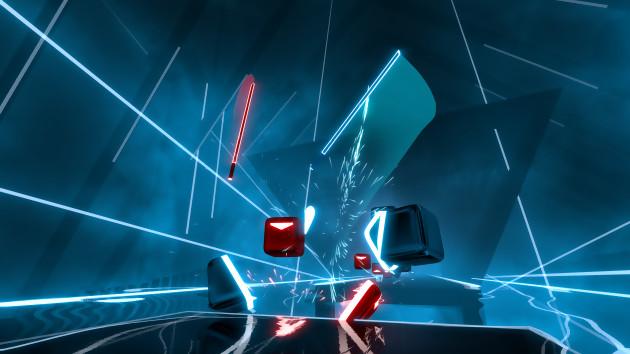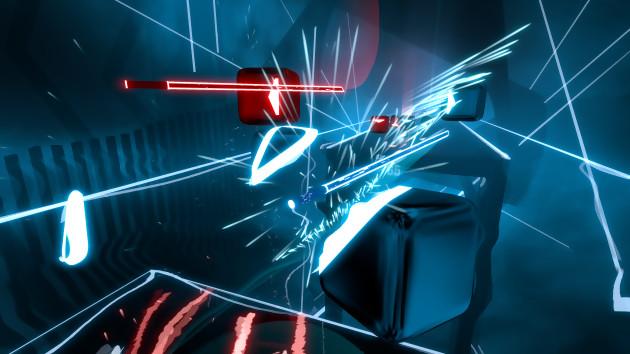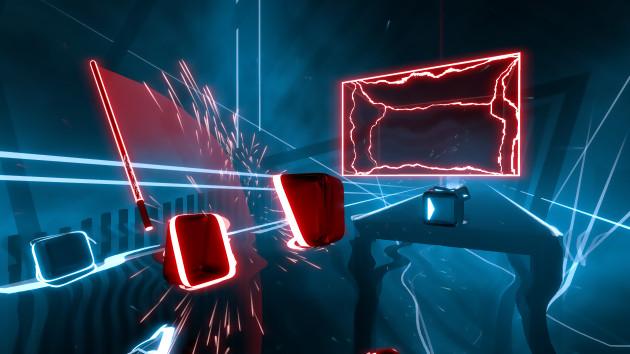 “Simple, basic”. We don't know if Orelsan had the opportunity to get his hands on Beat Saber, but he certainly wouldn't deny the extreme simplicity of the mechanics. The player has two sabers – one red, the other blue – embodied by the PlayStation Move. As in any other rhythm game, blocks scroll across the screen, and it is therefore necessary to slice them in the direction indicated (up, down, left, right, diagonally) while respecting their color. From time to time, we are entitled to a few neutral cubes that allow us to catch our breath, but this respite is always short-lived. So much for the fundamentals. Of course, the Czech studio has slipped in a few subtleties to make the exercise more difficult. For example, there are obstacles that one must avoid by shifting to the right or to the left, or by crouching. It is also necessary to be careful not to cut the bombs under penalty of destroying the combo. More vicious, the blocks placed side by side with opposite directions, which requires a little tense neuronal gymnastics when the tempo is high. We can also cite the notes that go out of their usual zone – normally, the red cubes are placed on the left, and the blue ones on the right – to force us to split them with the opposite sword. We won't teach anything to fans of the genre: the best way to succeed in Beat Saber is to anticipate. It is clear that if we are content to read the notes once they are under our noses, we will be overwhelmed fairly quickly. The gaze must constantly be focused on the background so as not to suffer and to be able to prepare the next stroke of the blade. It doesn't seem like it, but Beat Saber places a lot of importance on style, and the positioning of the blocks means that you are unknowingly performing a choreography that recalls the days when DJ 8-Ball ruled the roost. Dance Dance Revolution.
“Simple, basic”. We don't know if Orelsan had the opportunity to get his hands on Beat Saber, but he certainly wouldn't deny the extreme simplicity of the mechanics. The player has two sabers – one red, the other blue – embodied by the PlayStation Move. As in any other rhythm game, blocks scroll across the screen, and it is therefore necessary to slice them in the direction indicated (up, down, left, right, diagonally) while respecting their color. From time to time, we are entitled to a few neutral cubes that allow us to catch our breath, but this respite is always short-lived. So much for the fundamentals. Of course, the Czech studio has slipped in a few subtleties to make the exercise more difficult. For example, there are obstacles that one must avoid by shifting to the right or to the left, or by crouching. It is also necessary to be careful not to cut the bombs under penalty of destroying the combo. More vicious, the blocks placed side by side with opposite directions, which requires a little tense neuronal gymnastics when the tempo is high. We can also cite the notes that go out of their usual zone – normally, the red cubes are placed on the left, and the blue ones on the right – to force us to split them with the opposite sword. We won't teach anything to fans of the genre: the best way to succeed in Beat Saber is to anticipate. It is clear that if we are content to read the notes once they are under our noses, we will be overwhelmed fairly quickly. The gaze must constantly be focused on the background so as not to suffer and to be able to prepare the next stroke of the blade. It doesn't seem like it, but Beat Saber places a lot of importance on style, and the positioning of the blocks means that you are unknowingly performing a choreography that recalls the days when DJ 8-Ball ruled the roost. Dance Dance Revolution.
With its sleek and futuristic design, Beat Saber is one of those games that doesn't need to layer textures to transport you to another dimension.
 This desire to make us hyper-class Japanese warriors is found in the scoring system which encourages us to apply gestures. Indeed, it is not enough to slice the blocks in rhythm to collect the maximum points, we must also make sure: 1) to raise our arm with an angle of at least 90° before cutting the cube, 2) to continue the movement so as to reach an angle of 60° after the stroke of the blade, 3) to cut the note into two equal parts. In addition to these three parameters, there is the traditional multiplier (up to x8) which boosts the points when the combo counter goes crazy. Intertwined, these mechanics make you sweat a lot when playing Beat Saber; at least, as far as we are concerned. We had more than once interrupt our game because fog was starting to form on the lenses of the PlayStation VR, degrading visibility. Afterwards, we have cheated so much in other musical games, tolerance has taken precedence over skill so much, that we appreciate that Hyperbolic Magnetism is demanding. And then, there is this feeling of satisfaction when we arrive at the end of a piece that intoxicates you, the notes putting our nerves, our concentration and our reflexes to the test. In terms of content, Beat Saber has a "Campaign" mode that allows you to discover all the music in the game through increasing difficulty. Sadistic to the end, the developers have integrated objectives that are more or less easy to fulfill. At times, the number of blocks missed or cut with the wrong sword will be limited, the pace of the piece will go faster or slower, we will have to travel a certain distance by waving our arms, or even the direction in which to slice the cube will disappear at the end of the day. last moment.
This desire to make us hyper-class Japanese warriors is found in the scoring system which encourages us to apply gestures. Indeed, it is not enough to slice the blocks in rhythm to collect the maximum points, we must also make sure: 1) to raise our arm with an angle of at least 90° before cutting the cube, 2) to continue the movement so as to reach an angle of 60° after the stroke of the blade, 3) to cut the note into two equal parts. In addition to these three parameters, there is the traditional multiplier (up to x8) which boosts the points when the combo counter goes crazy. Intertwined, these mechanics make you sweat a lot when playing Beat Saber; at least, as far as we are concerned. We had more than once interrupt our game because fog was starting to form on the lenses of the PlayStation VR, degrading visibility. Afterwards, we have cheated so much in other musical games, tolerance has taken precedence over skill so much, that we appreciate that Hyperbolic Magnetism is demanding. And then, there is this feeling of satisfaction when we arrive at the end of a piece that intoxicates you, the notes putting our nerves, our concentration and our reflexes to the test. In terms of content, Beat Saber has a "Campaign" mode that allows you to discover all the music in the game through increasing difficulty. Sadistic to the end, the developers have integrated objectives that are more or less easy to fulfill. At times, the number of blocks missed or cut with the wrong sword will be limited, the pace of the piece will go faster or slower, we will have to travel a certain distance by waving our arms, or even the direction in which to slice the cube will disappear at the end of the day. last moment.
CLEAR SABER
 In the latter case, even if one does not have a very good memory, there is a way to rely on the rotation of the blocks which is linked to the direction in which they must be sheared. We won't go so far as to make a comparison with the Tetris effect, but we have to admit that once caught up in this whirlwind of bare notes, we end up wielding the swords instinctively, based on this musical logic that emerges implicitly. It's quite a crazy feeling, really. Apart from the "Campaign" mode, you can also squat the "Free Play" mode where you have access to all the tracks of the game. The level of difficulty is of course configurable, and you can even activate handicaps (the same than in the "Campaign" mode) to inflate the multiplier and appear better in the online ranking. But the most interesting remains the possibility of focusing on a particular sequence of the piece; the ideal tool to pinpoint our weaknesses and erase them. As for the “Party” mode, it allows several players to share the PlayStation VR to slam the best possible score through a local leaderboard. Unlike FreeStyle Games, which had made the effort to offer split-screen versus in DJ Hero, Hyperbolic Magnetism is rather lazy in this area. Accused of cutting players off from the rest of the world, virtual reality would have nevertheless benefited from an emulation between two players by headset. There, apart from the scores, we cannot say that the competitive spirit is pushed to the limit. Fortunately, the developers have promised to rectify the situation soon, now that the PS4 version is available on the market. We cross our fingers so that the planned updates are not only deployed on PC.
In the latter case, even if one does not have a very good memory, there is a way to rely on the rotation of the blocks which is linked to the direction in which they must be sheared. We won't go so far as to make a comparison with the Tetris effect, but we have to admit that once caught up in this whirlwind of bare notes, we end up wielding the swords instinctively, based on this musical logic that emerges implicitly. It's quite a crazy feeling, really. Apart from the "Campaign" mode, you can also squat the "Free Play" mode where you have access to all the tracks of the game. The level of difficulty is of course configurable, and you can even activate handicaps (the same than in the "Campaign" mode) to inflate the multiplier and appear better in the online ranking. But the most interesting remains the possibility of focusing on a particular sequence of the piece; the ideal tool to pinpoint our weaknesses and erase them. As for the “Party” mode, it allows several players to share the PlayStation VR to slam the best possible score through a local leaderboard. Unlike FreeStyle Games, which had made the effort to offer split-screen versus in DJ Hero, Hyperbolic Magnetism is rather lazy in this area. Accused of cutting players off from the rest of the world, virtual reality would have nevertheless benefited from an emulation between two players by headset. There, apart from the scores, we cannot say that the competitive spirit is pushed to the limit. Fortunately, the developers have promised to rectify the situation soon, now that the PS4 version is available on the market. We cross our fingers so that the planned updates are not only deployed on PC.
With calibrated motion recognition, a hellish playlist and oiled mechanics, the title of Hyperbolic Magnetism stands out as one of the safe bets of the Sony Interactive Entertainment headset.
 With its sleek and futuristic design, Beat Saber is one of those games that doesn't need to layer textures to transport you to another dimension. The glow of the sabers is obviously reminiscent of Star Wars, but there is also TRON when the neon lights are linked on the screen. Fluid from start to finish, the game does not suffer from any problems with readability, which is the number one priority in a game of this type. The other imperative is the recognition of movements which must be on point to benefit from maximum precision. There again, nothing to say, the algorithm being flexible enough not to have to dislocate the arm with each blow of saber. Impossible to complete this Beat Saber test without mentioning the electro playlist. Don't expect to shake your blades on Daft Punk, Justice, Lifelike, Prodigy, Kavinsky or even Eric Prydz, since the majority of the music was composed by Jaroslav Beck, an artist from the country. We imagine that in terms of budget, it weighed less than investing in expensive licenses. It's not a problem anyway, since the guy did an incredible job, our favorite going to Escape feat. Summer Haze. Balearic Pumping is doing well too, as is $1 Bills. In short, it's looping on SoundCloud. Today, the Beat Saber soundtrack has 100 tracks, and paid packs (each containing around ten tracks) are expected to arrive in the coming weeks. Their price should be around €18, a steep price when you know that you already have to spend €10 to buy the game. On PC, in addition to having the chance to buy it cheaper (€30), the community also has a level editor available to integrate its own ziks. On PS20? Nothing at present.
With its sleek and futuristic design, Beat Saber is one of those games that doesn't need to layer textures to transport you to another dimension. The glow of the sabers is obviously reminiscent of Star Wars, but there is also TRON when the neon lights are linked on the screen. Fluid from start to finish, the game does not suffer from any problems with readability, which is the number one priority in a game of this type. The other imperative is the recognition of movements which must be on point to benefit from maximum precision. There again, nothing to say, the algorithm being flexible enough not to have to dislocate the arm with each blow of saber. Impossible to complete this Beat Saber test without mentioning the electro playlist. Don't expect to shake your blades on Daft Punk, Justice, Lifelike, Prodigy, Kavinsky or even Eric Prydz, since the majority of the music was composed by Jaroslav Beck, an artist from the country. We imagine that in terms of budget, it weighed less than investing in expensive licenses. It's not a problem anyway, since the guy did an incredible job, our favorite going to Escape feat. Summer Haze. Balearic Pumping is doing well too, as is $1 Bills. In short, it's looping on SoundCloud. Today, the Beat Saber soundtrack has 100 tracks, and paid packs (each containing around ten tracks) are expected to arrive in the coming weeks. Their price should be around €18, a steep price when you know that you already have to spend €10 to buy the game. On PC, in addition to having the chance to buy it cheaper (€30), the community also has a level editor available to integrate its own ziks. On PS20? Nothing at present.

























